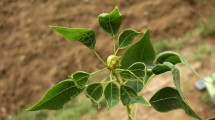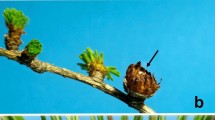Abstract
Outbreaks of herbivorous insects result in serious damage to forest trees. The gall midge Schizomyia castanopsisae (Diptera: Cecidomyiidae) induces inflorescence galls and causes severe loss of acorn production for Castanopsis sieboldii (Fagaceae). The outbreaks of gall midge have been occurring in these decades in the southern parts of the Izu Islands, Tokyo, Japan. In this study, we first found S. castanopsisae on Toshima Island, the Izu Islands, and in Izu Peninsula, Honshu. A genetic analysis showed that the genotype of the gall midge collected from the Izu Peninsula was identical to that from the Izu Islands, and only the haplotype was distributed in these areas. In contrast, the analysis of S. castanopsisae populations on the Nansei Islands of Japan found five haplotypes, including the one common to the Izu Peninsula and the Izu Islands. These results support the hypothesis that the gall midge populations occurring on the Izu Islands originate from the Nansei Islands, and the invaded populations have been expanding their range to the northern areas there. To monitor the distribution range and abundance of S. castanopsisae and its influences on the acorn production of C. sieboldii in Honshu are of urgent necessity.





Similar content being viewed by others
Data availability
The datasets are available from the corresponding author on reasonable request.
References
Avtzis DN, Melika G, Matošević D, Coyle DR (2019) The Asian chestnut gall wasp Dryocosmus kuriphilus: a global invader and a successful case of classical biological control. J Pest Sci 92:107–115
Barbosa P, Letourneau D, Agrawal A (2012) Insect outbreaks revisited. Wiley-Blackwell, Oxford
Elsayed AK, Yukawa J, Tokuda M (2018) A taxonomic revision and molecular phylogeny of the eastern Palearctic species of the genera Schizomyia Kieffer and Asteralobia Kovalev (Diptera, Cecidomyiidae, Asphondyliini), with descriptions of five new species of Schizomyia from Japan. Zookeys 808:123–160
Funk DJ, Futuyama DJ, Orti G, Meyer A (1995) Mitochondrial DNA sequences and multiple data sets: a phylogenetic study of phytophagous beetles (Chrysomelidae: Opharaella). Mol Biol Evol 12:627–640
Gibbs M, Schönrogge K, Alma A, Melika G, Quacchia A, Stone GN, Aebi A (2011) Torymus sinensis: a viable management option for the biological control of Dryocosmus kuriphilus in Europe? Biocontrol 56:527–538
Kotaka N, So Y, Elsayed AK, Tokuda M (2022) Collection records of Schizomyia castanopsisae on Amami-Ohshima and Tokunoshima Islands. Pulex 101:956–959 (In Japanese)
Lin S-F, Tung G-S, Yang M-M (2021) The Erythrina gall wasp Quadrastichus erythrinae (Insecta: Hymenoptera: Eulophidae): invasion history, ecology, infestation and management. Forests 12:948
MacLean DA (2016) Impacts of insect outbreaks on tree mortality, productivity, and stand development. Can Entomol 148:S138–S159
Moriya S, Shiga M, Adachi I (2003) Classical biological control of the chestnut gall wasp in Japan. In: van Driesche RG (ed) Proceedings of the 1st international symposium on biological control of arthropods, pp 407–415. United States Department of Agriculture, Forest Service
Nagai A (2010) Insect galls of Miyazaki Prefecture (II). Nishimoro No Seibutsu 3:7–38 (in Japanese)
Naito A, Tokuda M (2018) Predation by birds on larvae of Schizomyia sp. (Diptera: Cecidomyiidae) leaving infructescence galls on Castanopsis sieboldii (Fagaceae). Miyakensis 21:47–53 (in Japanese)
Simon C, Frati F, Beckenbach A, Crespi B, Liu H, Flook P (1994) Evolution, weighting, and phylogenetic utility of mitochondrial gene-sequences and a compilation of conserved polymerase chain-reaction primers. Ann Entomol Soc Am 87:651–701
Sunose T (1983) Studies on the population dynamics of the euonymus gall midge Masakimyia pustulae Yukawa et Sunose (Diptera, Cecidomyiidae) under different environmental conditions. Kontyû 51:29–41
Sunose T (1985) Population regulation of the euonyms gall midge Masakimyia pustulae Yukawa and Sunose (Diptera: Cecidomyiidae) by hymenopterous parasitoids. Res Popul Ecol 27:287–300
Takashima A, Kudaka N, Abe S, Abe T, Kotaka N (2021) Mast seeding monitoring on Castanopsis sieboldii in the Central Ryukyus of Nansei Islands using a binocular. Kyushu J Res 74:69–72 (in Japanese)
Tamura K, Stecher G, Kumar S (2021) MEGA11: molecular evolutionary genetics analysis version 11. Mol Biol Evol 38:3022–3027
Tokuda M (2012) Biology of Asphondyliini (Diptera: Cecidomyiidae). Entomol Sci 15:361–383
Tokuda M (2014) Gall midges (Diptera: Cecidomyiidae) on the Izu Islands, Tokyo. Japan Nat inSects 49:26–29 (in Japanese)
Tokuda M, Kawauchi K (2013a) Arthropod galls found on Toshima and Shikinejima Islands, the Izu Islands. Japan Jpn J Syst Entomol 19:261–274
Tokuda M, Kawauchi K (2013b) Collection record of an unidentified gall midge associated with Castanopsis sieboldii from Kagoshima Prefecture. Pulex 92:616–617 (in Japanese)
Tokuda M, Shoubu M, Yamaguchi D, Yukawa J (2008) Defoliation and dieback of Abies firma (Pinaceae) trees caused by Parendaeus abietinus (Coleoptera: Curculionidae) and Polygraphus proximus (Coleoptera: Scolytidae) on Mount Unzen. Jpn Appl Entomol Zool 43:1–10
Tokuda M, Matsuo K, Yukawa J (2012a) Insect galls found on Mikurajima and Aogashima, the Izu Islands, Tokyo. Japan Jpn J Entomol (n Ser) 15:75–84 (in Japanese with English summary)
Tokuda M, Matsuo K, Yukawa J (2012b) Insect galls found on Miyakejima and Hachijojima, the Izu Islands, Tokyo, Japan. Esakia 52:59–66
Tokuda M, Matsuo K, Kiritani K, Yukawa J (2013) Insect galls found on Ohshima, Kozushima and Niijima Islands, the Izu Islands, Tokyo, Japan, Makunagi. Acta Dipterol 25:1–16
Tokuda M, Kawauchi K, Kikuchi T, Iwasaki Y (2015) Arthropod galls newly found on the Izu Islands, Tokyo, Japan. Jpn J Syst Entomol 21:363–365
Tokuda M, Matsunaga K, Elsayed AK, Matsuda H (2019) New host and distribution records for Schizomyia castanopsisae (Diptera: Cecidomyiidae) from Fukuoka, northern Kyushu, Japan. Jpn J Syst Entomol 25:61–62
Tokuda M, Kawauchi K, Matsuda H, Naito A, So Y, Elsayed AK, Kikuchi T, Kotaka N (2022) Hundreds of billions of silent outbreaks: a historic outbreak record of the gall midge Schizomyia castanopsisae (Diptera: Cecidomyiidae) on the Izu Islands, Tokyo, Japan, and its potential mechanism. Entomol Sci 25:e12524
Yamauchi S, Ikenaga H, Yukawa J (1982) Midge galls collected from the south-west islands of Japan. Satsuma 31:1–23 (in Japanese with English summary)
Yukawa J (2021) Population study. In: Yukawa J, Tokuda M (eds) Biology of gall midges. Springer, Singapore, pp 167–184
Yukawa J, Masuda H (1996) Insect and mite galls of Japan in color. Zenkoku Nôson Kyôiku Kyôkai, Tokyo (in Japanese with English explanations for color plates)
Yukawa J, Ogata K, Kaburagi K, Tokuda M (2013) Cecidomyiid galls found on Tanegashima Island. Satsuma 150:48–61 (In Japanese)
Yukawa J, Miyamoto K, Yamaguchi T, Takesaki K, Uechi N, Matsuo K (2016) Key factor/key stage analysis of long-term life table data for a fruit gall midge, Asphondylia sphaera (Diptera: Cecidomyiidae). Ecol Entomol 41:516–526
Yukawa J, Matsuo K, Fujii T (2021a) Natural enemies with special reference to parasitic wasps. In: Yukawa J, Tokuda M (eds) Biology of gall midges. Springer, Singapore, pp 225–251
Yukawa J, Tokuda M, Kim W (2021b) Island biogeography. In: Yukawa J, Tokuda M (eds) Biology of gall midges. Springer, Singapore, pp 81–116
Acknowledgements
This study was supported in part by JSPS KAKENHI Grant Number JP21H02208 to MT. DNA sequencing was conducted at Analytical Research Center for Experimental Sciences, Saga University.
Author information
Authors and Affiliations
Corresponding author
Additional information
Publisher's Note
Springer Nature remains neutral with regard to jurisdictional claims in published maps and institutional affiliations.
Rights and permissions
Springer Nature or its licensor (e.g. a society or other partner) holds exclusive rights to this article under a publishing agreement with the author(s) or other rightsholder(s); author self-archiving of the accepted manuscript version of this article is solely governed by the terms of such publishing agreement and applicable law.
About this article
Cite this article
Tokuda, M., So, Y. & Kotaka, N. Discovery of the gall midge Schizomyia castanopsisae (Diptera: Cecidomyiidae) inducing inflorescence galls on Castanopsis sieboldii (Fagaceae) from Honshu, Japan and the possibility of its recent range expansion. Appl Entomol Zool 58, 315–322 (2023). https://doi.org/10.1007/s13355-023-00834-9
Received:
Accepted:
Published:
Issue Date:
DOI: https://doi.org/10.1007/s13355-023-00834-9




